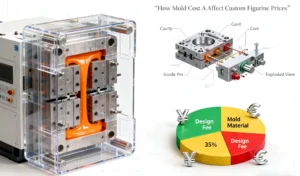1. Introduction
In the world of collectible toys and custom figures, material selection is one of the most critical decisions you will make. Whether you are producing resin statues, PVC action figures, or sofubi art toys, the choice of material will determine not only the quality and durability of your product but also the manufacturing cost, production timeline, and overall customer satisfaction.
This guide is designed for brand owners, designers, and IP holders who want to create premium, export-ready products. We’ll explore the most common figure materials, key selection criteria, and practical tips to balance performance with cost.
2. Common Materials in Figure Manufacturing
PVC (Polyvinyl Chloride)
- Pros: Durable, flexible enough for fine details, affordable for mass production.
- Cons: Can lose shape under high heat, not as premium-feeling as resin.
- Best for: Mass-produced static figures, anime characters, and accessories.
ABS (Acrylonitrile Butadiene Styrene)
- Pros: Strong, rigid, and ideal for structural parts like joints or bases.
- Cons: Less flexible, limited detail compared to PVC or resin.
- Best for: Figure skeletons, weapons, mechanical components.
Resin
- Pros: Exceptional detail reproduction, premium weight and texture.
- Cons: Brittle, higher production cost, longer lead time.
- Best for: High-end statues, limited editions, intricate sculptures.
Sofubi / Soft Vinyl
- Pros: Lightweight, compressible, and resistant to breakage.
- Cons: Limited sharp detailing, usually requires hand-painting.
- Best for: Designer toys, retro-style collectibles, large figures.
Mixed Materials
- Pros: Combines strengths of different materials for better performance.
- Cons: More complex manufacturing and assembly.
- Best for: Multi-part figures, hybrid collectibles.
3. Key Factors When Choosing Materials
- Product Positioning
- Are you targeting high-end collectors or a wider retail audience?
- Limited edition vs. mass production.
- Detail & Aesthetics
- Resin offers the highest sculpt detail, PVC is a balanced option, sofubi has a softer aesthetic.
- Durability & Safety
- Resistance to breakage, heat, and UV exposure.
- Compliance with international toy safety standards (EN71, ASTM F963, CPSIA).
- Manufacturing Feasibility
- Mold cost, production efficiency, compatibility with your supplier’s equipment.
- Paint & Finish Compatibility
- Some materials hold paint better and offer richer color reproduction.
- Regulatory Compliance
- For export to the US and EU, ensure compliance with RoHS and REACH regulations.
4. Material Recommendations by Product Type
- Static display figures → Resin or PVC for balance between detail and cost.
- Art toys & sofubi collectibles → Soft vinyl for its tactile charm and retro appeal.
- Articulated action figures → ABS for structure + PVC for detail parts.
- Large-scale statues → Lightweight resin or composite materials.
- Accessories & props → ABS for strength, resin for fine detailing.

5. Balancing Quality and Cost
- Resin is best for detail but more expensive and fragile.
- PVC is cost-effective for large runs without losing too much detail.
- Sofubi is ideal for niche art toys with lower tooling costs.
- Combine materials strategically to optimize budget while maintaining quality.
6. Quality Testing & Supplier Selection
Essential Quality Tests
- Drop test for packaging and shipping durability.
- Heat resistance test for storage and transportation safety.
- Paint adhesion test to ensure long-lasting color.
Choosing the Right Manufacturing Partner
- Look for a toy factory with proven OEM/ODM experience.
- Check past projects and export history.
- Ask for material certifications and safety test reports.
7. Future Trends in Figure Materials
- Sustainable plastics made from bio-based resources.
- 3D-printed resin prototypes for faster design validation.
- Smart materials with light-reactive or color-changing effects.
Finally, a form is attached for your reference
| Material | Detail Quality | Durability | Cost | Paint/Finish Compatibility | Best For | Notes |
|---|---|---|---|---|---|---|
| Resin | ⭐⭐⭐⭐⭐ (Excellent) | ⭐⭐ (Fragile) | High | Excellent | High-end statues, limited editions | Premium feel, great for intricate designs, fragile |
| PVC | ⭐⭐⭐⭐ (Good) | ⭐⭐⭐⭐ (Durable) | Medium | Good | Mass-produced figures, action figures | Balanced choice, cost-effective, fine details possible |
| ABS | ⭐⭐⭐ (Moderate) | ⭐⭐⭐⭐⭐ (Very Durable) | Medium | Moderate | Structural parts, joints, bases | Strong and rigid, less detail, often combined with PVC |
| Sofubi (Soft Vinyl) | ⭐⭐⭐ (Moderate) | ⭐⭐⭐ (Flexible) | Low-Medium | Moderate | Designer toys, retro-style figures | Soft texture, lightweight, less sharp detail |
| Mixed Materials | ⭐⭐⭐⭐ (Good) | ⭐⭐⭐⭐ (Durable) | Variable | Good | Multi-part figures, hybrid collectibles | Combines strengths of multiple materials for optimized performance |
8. Conclusion
Selecting the right material for your custom figure project is more than a technical choice—it’s a strategic decision that impacts quality, cost, and market appeal. By understanding the strengths and limitations of resin, PVC, ABS, and sofubi, brands can align their product vision with the most suitable manufacturing approach. Whether your goal is to create premium resin statues, mass-produced PVC figures, or unique sofubi collectibles, partnering with an experienced OEM/ODM toy factory ensures consistent quality, compliance with international standards, and a smooth production process.
Ready to bring your ideas to life? Contact our team today to discuss the best material solutions for your next custom figure.
💼Looking for a reliable custom figure partner?
📧 Email:stella@mihotoyz.com
🌐 Website:https://newmiho.com/
📞 WhatsApp:+86 13266641166
🏭 Address:6F, Building B, Baocheng Taiji Industrial Park,Guangdong, China




